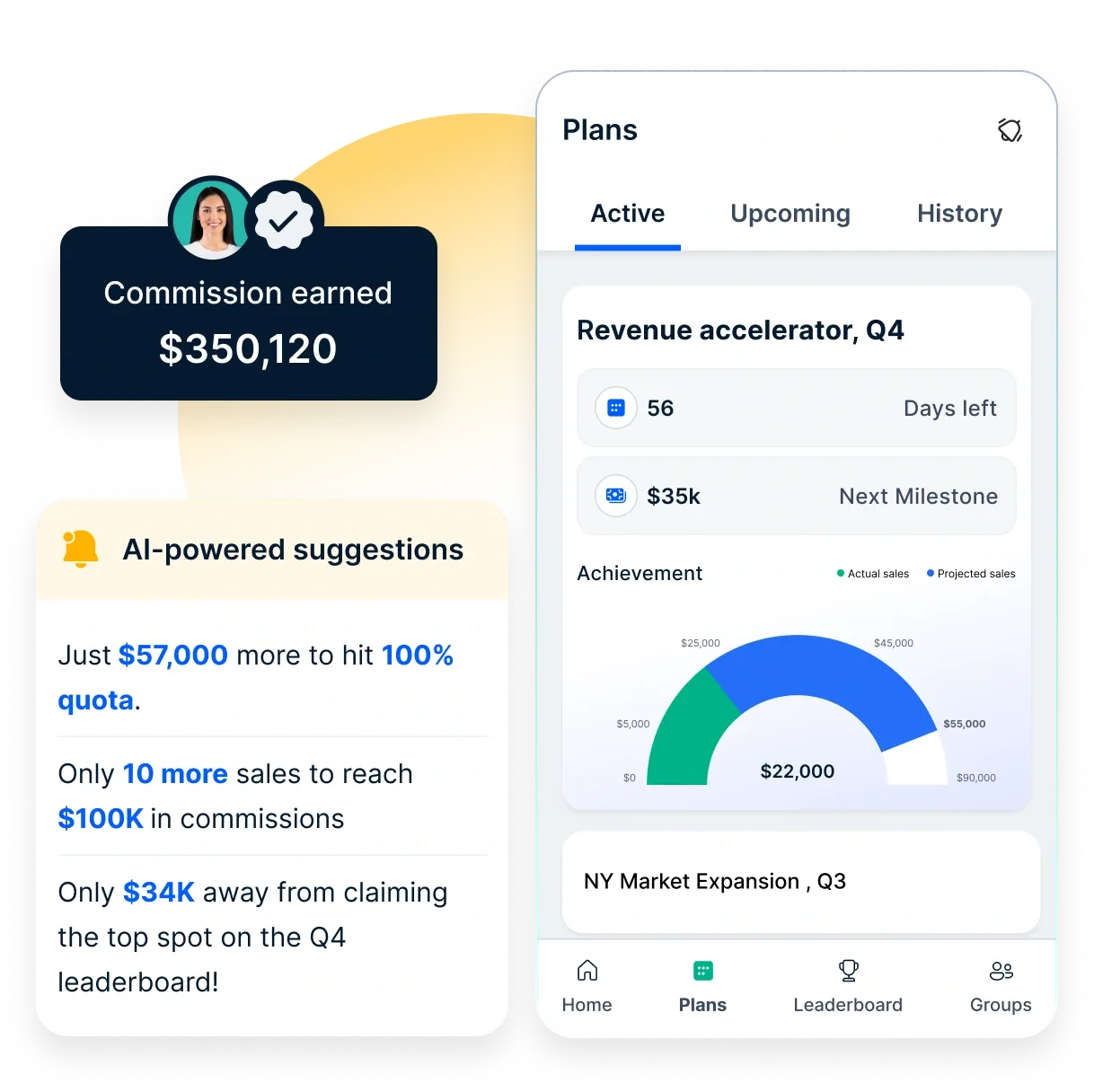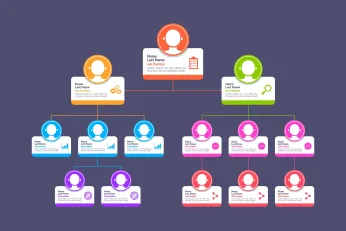8 passaggi su come calcolare la commissione di vendita con struttura della commissione, formule ed esempi
Vi è mai capitato di presentare guadagni errati per le vostre commissioni di vendita e di subire una perdita? Oppure avete visto che è successo a qualcuno e temete che possa succedere anche a voi? Allora date un'occhiata a questa facile formula per le percentuali delle commissioni di vendita e presentate sempre le cifre corrette.
In questa pagina
Uno studio indica che le organizzazioni rischiano di perdere fino al30% delleopportunità di vendita a favore della concorrenza. Ciò evidenzia l'importanza di valutare il processo e le metriche di vendita. Con strumenti adeguati, un'organizzazione può aumentare del 20% il raggiungimento delle quote di vendita e stabilire un processo di vendita snello e accurato.
Tale circostanza è stata dimostrata da uno dei più importanti leader mondiale nel settore dei CNC che ha cambiato facilmente la traiettoria delle vendite e ha scalato rapidamente. Con un team numeroso distribuito in oltre 32 sedi di vendita e assistenza in tutto il mondo, questa azienda ha dovuto affrontare delle sfide per automatizzare le commissioni.
I loro obiettivi principali erano quelli di consentire ai rappresentanti di vendita un facile accesso ai dati relativi agli incentivi, ridurre significativamente il tempo dedicato al calcolo delle commissioni ed eliminare il carico di lavoro manuale precedentemente gestito dal responsabile delle vendite.
Hanno integratoCompass, un software per la gestione delle commissioni di vendita. Compass offriva funzionalità quali flussi di lavoro del programma, motori di regole automatizzate, processi di approvazione, classifiche, scorecard e un'applicazione mobile per il monitoraggio delle prestazioni in tempo reale. L'organizzazione ha ottenuto una visibilità in tempo reale sul calcolo degli incentivi.
Inoltre, ha garantito l'accuratezza dei pagamenti, ha eliminato la dipendenza dal team di gestione delle vendite per la gestione manuale del processo delle commissioni e si è affidato al calcolo delle commissioni di vendita per automatizzare la procedura end-to-end.
Di conseguenza, il raggiungimento delle quote è aumentato del 20% in meno di 90 giorni, la partecipazione al programma è aumentata del 22% e l'adozione della piattaforma ha raggiunto il 73%.
Poiché un compenso equo è fondamentale per motivare i venditori, un calcolatore di commissioni di vendita diventa uno strumento importante. Pertanto, questo blog esplorerà aspetti importanti dei calcolatori di commissioni di vendita per aiutarvi a comprenderne l'utilità.
Che cos'è un calcolatore di commissioni di vendita?
Un calcolatore di commissioni di vendita o calcolatore di compensi di vendita è uno strumento che aiuta a calcolare la somma di denaro che un venditore guadagna in base alle sue prestazioni di vendita. In genere si inserisce l'importo delle vendite e il tasso di commissione e il calcolatore fornisce la commissione guadagnata. Un calcolatore di commissioni di vendita può aiutare un'organizzazione a mantenere:
- Precisione. Un calcolatore di commissioni SaaS garantisce il calcolo corretto delle commissioni per evitare errori manuali.
- Efficienza, poiché consente di risparmiare tempo automatizzando i calcoli. Di conseguenza, consente ai venditori di concentrarsi sulla vendita.
- Trasparenza, perché questo strumento fornisce informazioni chiare e immediate sui potenziali guadagni.
Analizziamo uno studio statistico sulle tecnologie di vendita per capire come uno strumento di questo tipo, aggiunto allo stack tecnologico, possa influenzare i risultati aziendali.
- Secondo uno studio distudio McKinseyl'80% dei chief sales officer ha dichiarato che disporre di uno stack tecnologico di vendita efficace è fondamentale per raggiungere gli obiettivi di fatturato.
- Lo stesso studio ha rivelato che l'80% dei responsabili delle vendite ritiene che le competenze analitiche e quantitative siano tra le più importanti.
- Un altro studio McKinsey ha rivelato che i player B2B che impiegano team di vendita omnichannel, tecnologia di vendita avanzata, automazione e analisi dei dati registrano10%crescita della quota di mercato.
- Lo stesso studio suggerisce che oltre il 30% delle attività e dei processi all'interno del ciclo di vendita possono essere in qualche modo automatizzati. Questo include attività che vanno dal calcolo delle commissioni di vendita, alla pianificazione e alla gestione dei lead fino alla generazione di preventivi.
- Lo studio ha inoltre rivelato che l'automazione aumenta i ricavi e porta a riduzioni dei costi di servizio fino al 20%, favorendo al contempo la soddisfazione dei clienti e dei dipendenti.
Anche se molte attività di vendita possono essere automatizzate, non tutti gli sforzi hanno lo stesso successo. Le aziende leader si concentrano sull'automazione di aree specifiche come la gestione dei lead, la stesura dei contratti, la generazione di incentivi tramite un calcolatore di commissioni di vendita e la pianificazione delle commissioni di vendita.
La tecnologia avanzata può automatizzare molte attività di vendita che richiedono tempo, liberando i venditori per concentrarsi su attività più importanti. Questo può portare a un aumento dei ricavi, a una riduzione dei costi e a una maggiore soddisfazione sia per i clienti che per i dipendenti.
Fattori essenziali per il calcolo delle commissioni di vendita
Il calcolo delle commissioni di venditaè essenziale per molte aziende, soprattutto per quelle che si affidano a un team di vendita per generare ricavi. Considerando l'importanza del processo, è necessario capire che per determinare l'importo della commissione da pagare a un venditore è necessario considerare diversi fattori essenziali.
Quindi, prima di spiegarvicome calcolare le commissioni di vendita, è meglio familiarizzare con i fattori essenziali che influenzano il calcolo delle commissioni di vendita.
1. Base della Commissione
La base della provvigione è il fatturato o il profitto su cui si basa la provvigione di un venditore. Può trattarsi del fatturato totale, del margine di profitto sulle vendite o di un'altra metrica che riflette il contributo del venditore ai profitti dell'azienda.
2. Tasso di commissione
Il tasso di commissione è la percentuale della base della commissione che un venditore riceverà come commissione. Ad esempio, se la base della commissione è di 100.000 dollari e il tasso di commissione è del 10%, il venditore riceverà una commissione di 10.000 dollari.
3. Periodo della Commissione
Il periodo di provvigione è l'arco di tempo in cui viene calcolata la provvigione. Può trattarsi di una settimana, di un mese, di un trimestre o di un altro periodo adeguato all'attività e al ciclo di vendita.
4. Livello della Commissione
Un livello di provvigione è una struttura che stabilisce diversi tassi di provvigione in base a diversi livelli di performance. Ad esempio, un addetto alle vendite potrebbe ricevere una commissione del 10% sui primi 50.000 dollari di vendite, del 12% sui successivi 50.000 dollari e del 15% su tutte le vendite superiori a 100.000 dollari.
In questo caso, l'applicazione del livello di provvigione appropriato è essenziale per garantire che l'addetto alle vendite sia compensato in qualche modo in base alle sue prestazioni.
5. Annullamento
L'override è una commissione aggiuntiva pagata a un venditore che gestisce un team di altri venditori. L'override è calcolato come percentuale della commissione guadagnata dai venditori del team.
6. Dividere
Si ricorre alla suddivisione quando due o più venditori collaborano a una vendita. In questo caso, la commissione viene suddivisa tra i venditori in base a una formula concordata. Ad esempio, la provvigione può essere divisa al 50% tra due venditori che hanno lavorato insieme a una vendita.
Questi fattori sono importanti da considerare nel calcolo delle provvigioni di vendita, in quanto possono incidere in modo significativo sulla provvigione percepita da un venditore. Prendendo in considerazione questi fattori e creando una struttura di provvigioni equa e trasparente, le aziende possono motivare il proprio team di vendita a raggiungere i propri obiettivi e a far crescere il fatturato.
Come calcolare le commissioni di vendita in 8 semplici passi?
Il calcolo delle commissioni di vendita prevede diverse fasi per garantire che gli addetti alle vendite siano compensati equamente per il loro lavoro. Anche se nel 2023 esistono tecnologie che consentono diautomatizzare il calcolo delle commissionicalcolo delle commissioni, è possibile che si voglia fare tutto manualmente.
Ecco quindi una spiegazione dettagliata dei passaggi necessari per calcolare le commissioni di vendita se si desidera procedere al calcolo manuale:
Fase 1: determinare il periodo di commissione
Il primo passo consiste nel determinare il periodo di commissione, ossia il periodo in cui la commissione verrà calcolata. Questo periodo può essere settimanale, mensile, trimestrale o annuale. Quindi, scegliete il periodo per il quale volete ottenere le commissioni e arrotondate per eccesso le vendite effettuate in questo periodo.
Fase 2: identificare la base delle commissioni
Identificate e tenete a portata di mano la base delle commissioni per ogni transazione di vendita per la quale state cercando di ottenere una commissione. Poiché l'importo di base può essere diverso per ogni vendita che si è riusciti a generare, è essenziale tenerne traccia per poterlo calcolare facilmente in seguito.
Fase 3: moltiplicare il tasso di provvigione per la base di provvigione
Ora che la base della commissione è pronta, moltiplicatela per il tasso di commissione per ottenere l'importo di base della commissione che vi spetta.
Ma ricordate che questo non è il valore finale, poiché possono esserci aggiunte o addirittura detrazioni su questo valore di base della commissione a seconda delle condizioni contrattuali.
Fase 4: considerare vari tassi di commissione
Modificare il valore dei tassi di commissione nel caso in cui il tasso sia diverso da quello normale.
Ad esempio, se il vostro tasso di commissione per un'attività o una transazione è del 10%, ma del 12% per un'altra attività/transazione, moltiplicate la base della commissione per quella particolare attività/transazione con il rispettivo tasso di commissione per un calcolo accurato.
Fase 5: Applicazione del livello di commissione (se applicabile)
Oltre ai diversi tassi di commissione di cui dovete tenere conto, dovete anche tenere traccia di tutte le attività/transazioni con tassi differenziati. Dato che la maggior parte delle transazioni di vendita non sono differenziate, è facile che ve ne sfugga una, nel qual caso sarete ricompensati molto meno di quanto vi spetta.
Per questo motivo, la cosa migliore è tenere un elenco separato delle aziende che offrono commissioni a livelli, insieme ai livelli stessi, per poterli calcolare comodamente alla fine del periodo di commissioni.
Fase 6: Calcolo della commissione di override
Richiedete la commissione che vi spetta per le vendite concluse con successo dai rappresentanti che gestite. Moltiplicate il tasso di commissione per il totale delle commissionii membri del vostro teame aggiungete il valore risultante al vostro calcolo delle commissioni.
Fase 7: dedurre eventuali resi
Annotare il valore delle commissioni ricevute fino all'ultima fase e dedurre eventuali guadagni derivanti da vendite annullate o restituite dal cliente.
Anche se inizialmente avete concluso l'affare, tali transazioni sono considerate nulle se alla fine la vostra azienda deve restituire il denaro o non lo ha ricevuto in primo luogo a causa dell'annullamento della vendita da parte del cliente.
Fase 8: Dividere la commissione (se applicabile)
Dal valore della commissione ottenuta, deducete la quota dei vostri colleghi se avete partecipato alla chiusura delle vendite con loro.
In questo modo, il calcolo della commissione finale di tutte le vendite può essere determinato come segue:
A =Base della commissione per il periodo di commissione determinato x Tassi di commissione rispettivi per le diverse transazioni
B =A + Valore della commissione secondo i diversi livelli
C =B + Quota della commissione guadagnata dai membri del team
D =C - Valore della commissione di vendita per le transazioni di vendita restituite o richiamate
E =D - Quota di vendita dei colleghi in caso di commissioni ripartite
Per calcolare ulteriormente la formula della percentuale di commissione di vendita, prendere il valore di "E" dalla formula precedente e dividerlo per "100".
8 Strutture delle commissioni di vendita e come calcolarle con la formula
I piani di provvigione per le vendite non sono uguali per tutti. La struttura ideale dipende dagli obiettivi, dal ciclo di vendita e dal modello di fatturato della vostra azienda.
Un piano ben progettato può stimolare la motivazione e le prestazioni, garantendo al tempo stesso un compenso equo. Di seguito sono riportate otto strutture commissionali comuni, insieme alle formule per il calcolo dei guadagni.
1. Stipendio base + commissioni
Questo modello combina uno stipendio fisso con una commissione basata sui risultati di vendita, offrendo stabilità finanziaria e incentivi alla crescita. Di seguito è riportata la formula delle commissioni:
Esempio: Un rappresentante guadagna uno stipendio base di 45.000 dollari più una commissione del 12%. Se genera 120.000 dollari di vendite, il suo guadagno totale sarà di 45.000 dollari + (120.000 dollari x 0,12) = 59.400 dollari.
Ideale per: Aziende con cicli di vendita imprevedibili
Pro: Incoraggia prestazioni costanti e riduce il rischio finanziario per i rappresentanti.
Contro: costi fissi più elevati per i datori di lavoro; può ridurre l'urgenza di massimizzare le vendite
2. Commissione basata sulle quote
Questo piano premia i rappresentanti con una commissione solo quando superano una quota di vendita stabilita, rendendola una strategia efficace per spingere le prestazioni elevate.
Esempio: Un rappresentante ha uno stipendio base di 3.500 dollari e guadagna una commissione del 18% sulle vendite che superano una quota di 12.000 dollari. Se genera 15.000 dollari di vendite, il suo guadagno sarà di 3.500 dollari + (3.000 dollari x 0,18) = 4.040 dollari.
Ideale per: Team di vendita esperti con obiettivi aggressivi
Pro: Motiva i rappresentanti a superare gli obiettivi, incrementando le entrate
Contro: può scoraggiare i rappresentanti se le quote sembrano irraggiungibili
3. Commissione diretta
I rappresentanti guadagnano una percentuale sulle vendite totali senza uno stipendio di base. Il tasso di commissione determina l'intero reddito. Di seguito è riportata la formula delle commissioni:
Esempio: Un rappresentante vende 8.000 dollari di prodotti con un tasso di commissione del 15%. Il suo guadagno sarebbe di 8.000 dollari x 0,15 = 1.200 dollari.
Ideale per: Professionisti delle vendite indipendenti o aziende con cicli di vendita brevi
Pro: Alto potenziale di guadagno e correlazione diretta tra sforzo e reddito
Contro: la variabilità del reddito può creare instabilità finanziaria.
4. Commissione residua
Questo modello premia i rappresentanti di vendita con commissioni ricorrenti da clienti di lunga data.
Esempio: Un cliente si abbona a un servizio da 1.500 dollari al mese. Il rappresentante guadagna una commissione del 6%, ricevendo 90 dollari al mese finché il cliente rimane abbonato.
Ideale per: Aziende SaaS e su abbonamento
Pro: Favorisce la fidelizzazione dei clienti a lungo termine
Contro: Può essere necessario del tempo per ottenere guadagni consistenti.
5. Commissione per il volume del territorio
Un modello basato sul team in cui la commissione viene suddivisa tra i rappresentanti in base al loro contributo alle vendite totali del territorio. La formula delle commissioni è la seguente:
Esempio: Il territorio di un rappresentante genera vendite per 70.000 dollari e le vendite totali del team raggiungono i 700.000 dollari con un tasso di commissione del 9%. Il guadagno del rappresentante sarebbe (70.000 dollari / 700.000 dollari) x 0,09 x 700.000 dollari = 6.300 dollari.
Ideale per: Grandi team di vendita che coprono territori geografici
Pro: Promuove il lavoro di squadra e lo sviluppo del mercato regionale
Contro: può creare controversie se i contributi non sono riconosciuti in modo equo
6. Commissione a livelli
I rappresentanti guadagnano commissioni più elevate man mano che raggiungono soglie di vendita più alte, incentivandoli a spingersi oltre gli obiettivi iniziali.
Esempio: Un piano offre una commissione del 5% sui primi 10.000 dollari di vendite, del 10% sulle vendite tra 10.000 e 20.000 dollari e del 15% sulle vendite superiori a 20.000 dollari. Un rappresentante che vende 25.000 dollari guadagnerebbe: (10.000 dollari x 0,05) + (10.000 dollari x 0,10) + (5.000 dollari x 0,15) = 2.250 dollari.
Ideale per: Team ad alte prestazioni con potenziale di vendita scalabile
Pro: Premia i venditori migliori e stimola la motivazione continua
Contro: può scoraggiare i lavoratori di livello inferiore se i livelli più alti sembrano irraggiungibili
7. Commissione sul margine lordo
Questo piano calcola le commissioni in base ai margini di profitto piuttosto che alle entrate, allineando gli incentivi alla redditività.
Esempio: Un prodotto con un margine lordo di 300 dollari e un tasso di commissione del 12% fa guadagnare a un rappresentante 300 dollari x 15 x 0,12 = 540 dollari.
Ideale per: Aziende che privilegiano il profitto rispetto al volume dei ricavi
Pro: Incoraggia la vendita di prodotti ad alto margine di guadagno
Contro: calcolo più complesso rispetto alle commissioni standard basate sui ricavi
8. Pareggio contro commissione
Questo modello prevede per i rappresentanti di vendita un pagamento anticipato che deve essere restituito attraverso le future commissioni.
Esempio: Un rappresentante riceve un'estrazione di 2.500 dollari. Se in seguito guadagna 4.000 dollari di commissioni, il suo compenso finale è di 4.000 dollari - 2.500 dollari = 1.500 dollari.
Ideale per: Nuovi assunti nel settore delle vendite o ruoli con reddito fluttuante
Pro: Fornisce sicurezza finanziaria ai rappresentanti durante i periodi di vendite lente.
Contro: può portare a tensioni finanziarie se le vendite non soddisfano le aspettative
In che modo Compass può aiutare nel calcolo delle commissioni di vendita?

Compass può semplificare in modo significativo l'automazione del calcolo delle vendite, eliminando i processi manuali e garantendo un monitoraggio accurato e in tempo reale delle commissioni. Ecco come Compass può aiutarvi:
1. Calcolo automatico delle commissioni
- Compass automatizza i calcoli delle commissioni di vendita utilizzando formule predefinite per il calcolo delle quote di vendita e regole personalizzabili, riducendo gli errori umani e garantendo la trasparenza.
- Supporta diverse strutture di commissioni, tra cui commissioni a livelli, incentivi basati su quote e commissioni residue.
- Funziona anche come calcolatore del raggiungimento della quota, perché mostra le pietre miliari e invia stimoli in base all'obiettivo raggiunto.
2. Monitoraggio in tempo reale del raggiungimento della quota
- I team di vendita possono monitorare il raggiungimento delle quote e i progressi verso gli incentivi utilizzando dashboard in tempo reale.
- I manager ottengono informazioni sull'andamento delle vendite e possono adeguare di conseguenza le strategie di remunerazione.
3. Formule di commissione personalizzabili
- Compass consente alle aziende di impostare diverse formule di commissioni in base ai ruoli, agli obiettivi di fatturato e ai livelli di prestazione.
- Funziona bene per i modelli di commissione SaaS, per le vendite di prodotti ad alto margine e per le strutture basate sul territorio.
4. Integrazione perfetta con gli strumenti di vendita e finanziari
- Si integra con le piattaforme CRM (Salesforce, HubSpot), con i sistemi ERP e con il software per le buste paga, garantendo un flusso di dati fluido.
- Riduce gli sforzi di riconciliazione manuale grazie all'estrazione dei dati di vendita in tempo reale per l'elaborazione automatica dei pagamenti.
Che si tratti di una startup o di un'azienda, Compass è in grado di scalare con il vostro team, facilitando l'adeguamento delle strutture delle commissioni in base all'evoluzione dell'attività. Con Compass è possibile gestire modelli di retribuzione multi-regione, multi-valuta e multi-livello senza alcuno sforzo. Programmate una chiamata ora!
Conclusione
La conversione dei lead in vendite richiede uno sforzo considerevole ed è necessario assicurarsi di essere adeguatamente compensati. A tal fine è necessario presentare i calcoli corretti, tenendo conto di tutto ciò che deve essere aggiunto o detratto.
Con questa semplice guida al calcolo delle provvigioni di vendita, potete ora assicurarvi che tutti i vostri sforzi siano riconosciuti e che riceviate ogni centesimo della provvigione che vi spetta. Quindi, arrotondate tutte le vostre transazioni di vendita e calcolate la vostra provvigione con questa formula della percentuale di provvigione sulle vendite, facile come"ABCD"!
Domande frequenti
1. Con quale frequenza vengono rivisti e aggiornati i tassi di commissione?
Dipende dalle politiche aziendali. Alcune società rivedono i tassi di commissione annualmente, mentre altre possono rivederli più o meno frequentemente.
2. La commissione viene pagata sul prezzo di vendita o sul margine di profitto?
Dipende dalle politiche aziendali. Alcune aziende pagano una commissione sul prezzo di vendita, mentre altre pagano una commissione sul margine di profitto.
3. Le commissioni sono soggette a imposte?
Sì, le commissioni sono considerate un reddito e sono soggette a imposte. Le imposte dovute dipendono dalla fascia fiscale di appartenenza e da altri fattori.
4. Come si calcola la commissione di vendita?
La formula di base per il calcolo è commissione = (totale delle vendite x tasso di commissione). Tuttavia, il calcolo delle commissioni può essere complicato perché dipende dalla struttura delle commissioni, dal settore e dai termini specifici del contratto.
Alcuni passaggi fondamentali per il calcolo delle commissioni includono la determinazione del periodo di commissione, il calcolo della base di commissione totale realizzata durante tale periodo e la moltiplicazione del tasso di commissione per la base di commissione.
Inoltre, è essenziale considerare i tassi di commissione variabili e graduali e completare tutti i calcoli e gli aggiustamenti aggiuntivi applicabili, come gli override, le deduzioni per i resi e le suddivisioni delle commissioni per i territori condivisi.
5. A quanto ammonta una commissione del 3% su 100 dollari?
Per calcolare una commissione del 3% su 100 dollari, moltiplicare 100 dollari per 3%3. Il calcolo è il seguente: $100 x 0.03 = $33.
6. Qual è la formula della commissione sugli utili?
La formula della commissione sul profitto lordo è: ricavi ($) - costi ($) = margine di profitto lordo ($) x tasso di commissione (%) = commissione totale ($)1 . Per calcolare la commissione sul profitto lordo in un foglio di calcolo, è possibile utilizzare la formula =(SOMMA(A1:A10)-SOMMA(B1:B10))*C1, dove A1:A10 è l'intervallo di celle contenenti gli importi delle vendite, B1:B10 è l'intervallo di celle contenenti il costo dei beni venduti e C1 è la percentuale di commissione.
7. Qual è la struttura media delle commissioni per le vendite?
La struttura commissionale media per le vendite prevede in genere uno stipendio di base combinato con una percentuale del fatturato generato dalle vendite. Le commissioni possono variare dal 5% al 20%, a seconda del settore, del prodotto e delle prestazioni individuali, con commissioni più elevate spesso legate al raggiungimento di specifici obiettivi di vendita. In fondo al modulo













